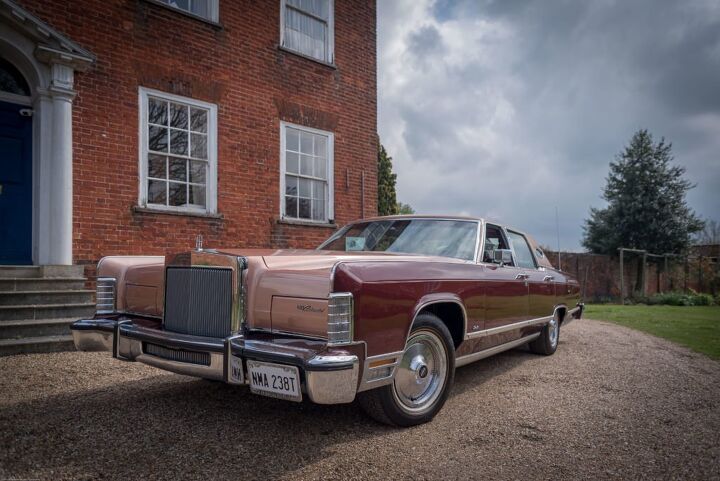Rare Rides: A Gigantic 1979 Lincoln Continental Town Car Williamsburg Edition

The end of the Seventies was a time of quiet reflection. A time where Americans pondered things like fuel prices, polyester suits, and what a large sedan should be. As the reality of automotive downsizing moved ever closer to realization, one or two of the large sedan dinosaurs had a last hurrah. Today’s Rare Ride is one such example.
It’s a 1979 Lincoln Town car; more specifically the extra-luxurious Williamsburg Edition.
The dawn of the Seventies was a much more hopeful time for the large car market in the United States. Ford was riding high on the success of its long and low fourth-generation Continental, which entered production in 1961, and the Continental’s revamped fourth generation remained in production for nine years. The Blue Oval sought modernization and cost savings when the time came for a fifth edition.
The outgoing generation was expensive to produce thanks to a model cycle separate from Ford and Mercury products, as well as an extended unibody chassis borrowed from the Thunderbird. For 1970, the Continental Town Car moved to a more affordable body-on-frame chassis shared with the Mercury Marquis. Said sharing meant the Continental’s now-famous suicide doors were no longer an option.
Already imposing, the new Continental’s length increased around five inches in 1973 (to 229.9″) after the installation of mandatory 5 mile-per-hour bumpers. Ford held onto its large sedans while the competition downsized. The Town Car gained roughly three more inches in 1974 (232.6″), and rounded off its last three years of tenure at 233 inches in length. For 1977, it was the largest mass-produced automobile in the world. For 1979, Ford and Mercury debuted downsized offerings while Lincoln marketed the Continental as the last large sedan. Time for a party in Williamsburg.
Introduced in 1977, the Williamsburg Edition added different visuals and standard equipment over other Town Cars. Two-tone paint worked with a vinyl roof and luxurious pinstripes. Inside, top of the line leather seats were six-way adjustable, and everyone was cooled via power vent windows. The first Williamsburg showed its conservative roots by omitting opera windows and exterior coach lighting. The flash returned in ’78 and ’79, with windows and lights aplenty.
Alas, the Williamsburg party was over for 1980, as the introduction of the Mark VI took everything down a peg.
Today’s Rare Ride enjoys the additional rarity bonus of a location in Ye Olde England, where it was driven by someone who enjoyed fitting large cars into small spaces. It’s equipped with the smaller 6.6-liter 400 V8 and shows in stunning apricot over dark cordovan. With 7,200 miles on the odometer, a British person is asked to pay $31,800.
[Images: seller]

Interested in lots of cars and their various historical contexts. Started writing articles for TTAC in late 2016, when my first posts were QOTDs. From there I started a few new series like Rare Rides, Buy/Drive/Burn, Abandoned History, and most recently Rare Rides Icons. Operating from a home base in Cincinnati, Ohio, a relative auto journalist dead zone. Many of my articles are prompted by something I'll see on social media that sparks my interest and causes me to research. Finding articles and information from the early days of the internet and beyond that covers the little details lost to time: trim packages, color and wheel choices, interior fabrics. Beyond those, I'm fascinated by automotive industry experiments, both failures and successes. Lately I've taken an interest in AI, and generating "what if" type images for car models long dead. Reincarnating a modern Toyota Paseo, Lincoln Mark IX, or Isuzu Trooper through a text prompt is fun. Fun to post them on Twitter too, and watch people overreact. To that end, the social media I use most is Twitter, @CoreyLewis86. I also contribute pieces for Forbes Wheels and Forbes Home.
More by Corey Lewis
Latest Car Reviews
Read moreLatest Product Reviews
Read moreRecent Comments
- AZFelix Let's forego all of this dilly-dallying with autonomous cars and cut right to the chase and the only real solution.
- Zelgadis Elantra NLine in Lava Orange. I will never buy a dirty dishwater car again. I need color in my life.
- Slavuta CX5 hands down. Only trunk space, where RAV4 is better.
- Kwik_Shift_Pro4X Oof 😣 for Tesla.https://www.naturalnews.com/2024-05-03-nhtsa-probes-tesla-recall-over-autopilot-concerns.html
- Slavuta Autonomous cars can be used by terrorists.







































Comments
Join the conversation
I own a '79 Town Car, and these truly are the 'last hurrah' of uncompromised size and an emphasis on supreme comfort. Often, sitting in that vast cabin made more vast by the white divided headliner and seats, I feel like it harkens back to the glory days of the 1950s cars, when long, low, and wide was reaching its first evolutionary headwind.
my grandfather bought a Cartier Edition town car new in '78... Jeez, I loved that car... crushed velour seats & all. In the early 80s, he traded for a Chrysler Fifth Avenue... which he absolutely HATED. In less than a year, he went back to a Grand Marquis, and remained with them for the next 20+ years. Both sets of grandparents drove the required Grand Marquis in South Florida. However, once I showed up with a '98 Mark VIII LSC, my grandfather was not about to be up-staged. Two weeks later, he bought a Town Car. I have a nostalgic twinge for the 70-79 Town Cars, but my personal fave is the '90-'97 Town Car...